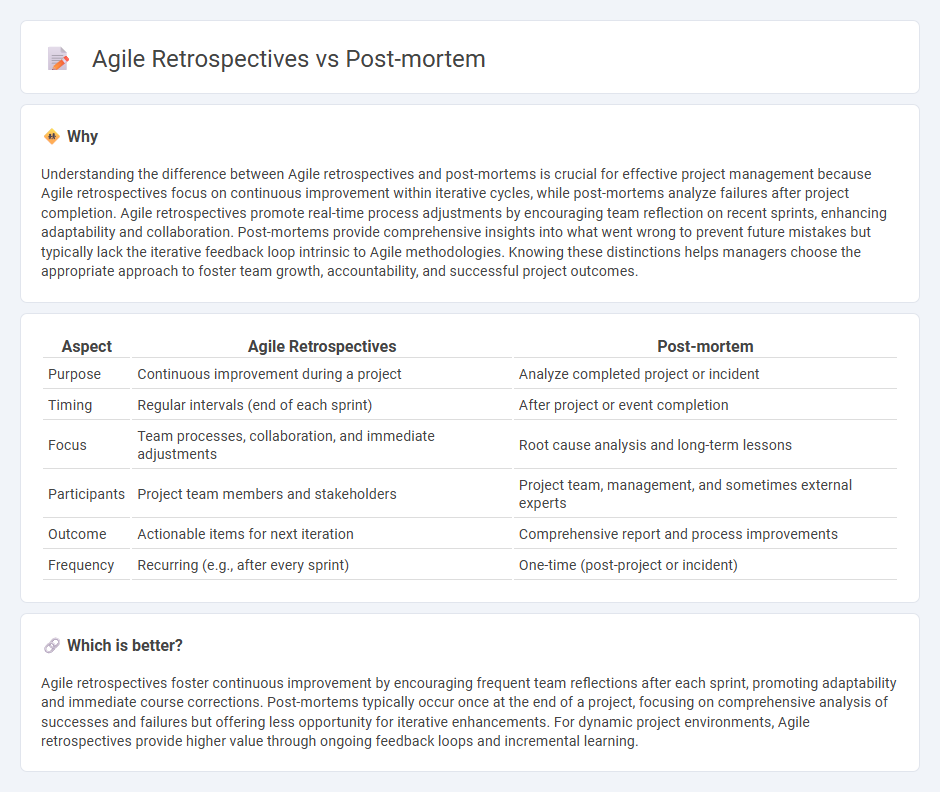
Agile retrospectives focus on continuous improvement through regular team reflections during a project, fostering collaboration and iterative learning. Post-mortem analysis occurs after project completion, aiming to identify successes and failures for future reference and accountability. Explore in-depth insights to understand which approach best suits your project management style.
Why it is important
Understanding the difference between Agile retrospectives and post-mortems is crucial for effective project management because Agile retrospectives focus on continuous improvement within iterative cycles, while post-mortems analyze failures after project completion. Agile retrospectives promote real-time process adjustments by encouraging team reflection on recent sprints, enhancing adaptability and collaboration. Post-mortems provide comprehensive insights into what went wrong to prevent future mistakes but typically lack the iterative feedback loop intrinsic to Agile methodologies. Knowing these distinctions helps managers choose the appropriate approach to foster team growth, accountability, and successful project outcomes.
Comparison Table
| Aspect | Agile Retrospectives | Post-mortem |
|---|---|---|
| Purpose | Continuous improvement during a project | Analyze completed project or incident |
| Timing | Regular intervals (end of each sprint) | After project or event completion |
| Focus | Team processes, collaboration, and immediate adjustments | Root cause analysis and long-term lessons |
| Participants | Project team members and stakeholders | Project team, management, and sometimes external experts |
| Outcome | Actionable items for next iteration | Comprehensive report and process improvements |
| Frequency | Recurring (e.g., after every sprint) | One-time (post-project or incident) |
Which is better?
Agile retrospectives foster continuous improvement by encouraging frequent team reflections after each sprint, promoting adaptability and immediate course corrections. Post-mortems typically occur once at the end of a project, focusing on comprehensive analysis of successes and failures but offering less opportunity for iterative enhancements. For dynamic project environments, Agile retrospectives provide higher value through ongoing feedback loops and incremental learning.
Connection
Agile retrospectives and post-mortems share a common goal of continuous improvement by analyzing completed work to identify successes and challenges. Both practices rely on team collaboration and honest feedback to foster learning and adapt future processes for enhanced productivity. Integrating insights from retrospectives and post-mortems drives effective management and project delivery optimization.
Key Terms
Continuous Improvement
Post-mortem analyses in project management emphasize identifying failures and lessons learned after project completion, whereas Agile retrospectives prioritize ongoing team reflection and iterative enhancements throughout the development process. Continuous improvement in Agile retrospectives drives enhanced collaboration, adaptability, and productivity by regularly addressing challenges and optimizing workflows after each sprint or iteration. Explore deeper insights to elevate your team's continuous improvement strategies through effective retrospective techniques.
Root Cause Analysis
Post-mortems and Agile retrospectives both aim to identify underlying issues, but post-mortems emphasize thorough root cause analysis of failures after project completion, while Agile retrospectives focus on continuous improvement during iterative cycles. Post-mortems utilize detailed problem-solving techniques like the Five Whys and Ishikawa diagrams to prevent recurrence, whereas retrospectives encourage team reflection and actionable adjustments for upcoming sprints. Explore how integrating these methods enhances project outcomes by understanding their unique approaches to root cause analysis.
Iterative Feedback
Post-mortem meetings analyze project outcomes after completion to identify successes and failures, while Agile retrospectives occur iteratively at the end of each sprint to foster continuous improvement and immediate feedback integration. Agile retrospectives promote adaptive process enhancements through team collaboration, making them pivotal for dynamic project environments. Discover how adopting iterative feedback mechanisms transforms team performance and project success rates.
Source and External Links
Post-mortem - NHS - A post-mortem (autopsy) is a medical examination of a body after death to determine the cause of death, usually performed by a pathologist, and may be requested by a coroner or hospital doctor for legal or medical reasons.
What happens during a post mortem - Royal College of Pathologists - During a post-mortem, the body is respectfully moved to a mortuary where a pathologist makes incisions to examine internal organs and tissues, often with the assistance of technologists, and may retain small tissue samples for further laboratory analysis.
Autopsy - Wikipedia - An autopsy involves both external and internal examination of a corpse, sometimes supplemented by toxicology or genetic tests, and after the procedure the body is carefully reconstructed so it can be viewed by relatives, with organs typically returned unless further investigation is authorized.
 dowidth.com
dowidth.com